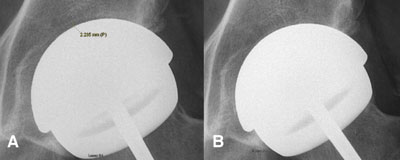Acetabular migration analysis reveals significant cup migration in resurfacing cases
Twenty-four percent of patients had acetabular cup migration greater than 1.2 mm.
Acetabular migration analysis revealed that patients with a hip resurfacing acetabular component had significant migration, according to Paul Beaulé, MD, FRCSC, who presented the study results at the 12th EFORT Congress 2011.
“Most of the early failures are due to femoral neck fracture,” Beaulé said. “However, acetabular loosening is becoming more of a worry for a variety of reasons, either because of the rigidity of the component, and basically, it is not a titanium interface for osteointegration as we have for primary THA [total hip arthroplasty].”
The researchers knew from other studies that Ein Bild Roentegen Analyse (EBRA) was accurate within 1 mm for migration assessment of cup failure in adult hip arthroplasty. Beaulé and his team wanted to assess early migration of the Conserve Plus Hip Resurfacing (Wright Medical Technology, Arlington, Tenn.) acetabular component in hip surfacing. The Conserve Plus has a cobalt bead interface of 50 µm to 150 µm, according to Beaulé.
“Also, we decided in subgroup analysis to look at the fate of the unseated acetabular component by way of migration analysis,” Beaulé said.
EBRA
Of 130 patients who underwent metal-on-metal hip resurfacing, the researchers included 66 hips in 60 patients who had sufficient radiographs to compare, had a primary diagnosis of osteoarthritis and no prior hip surgery. The patients had included 48 men and 12 women and were mean age of 50 years.
The team set limits for statistical significance at three radiographs for the comparability limit and >1.2 mm for the 2-year migration threshold. Mean follow-up was 25.3 months.
|
Images: Beaulé P |
The researchers used EBRA to measure migration horizontally and vertically on serial radiographs. They measured outcomes using SF-12 and WOMAC scores.
“We used a definition by Doug Naudia presented at the [AAOS 2011 Annual Meeting] where the immediate postoperative anteroposterior and cross-table lateral, if the maximal bone to cup distance was greater than 2 mm on either view, we consider these components unseated,” Beaulé said.
Of the hips, 26% were unseated.
Results
At 2 years, the average superomedial migration was 0.9 mm and 24% of acetabular cups migrated >1.2 mm. Two patients required revision for aseptic loosening at 34 months.
Age, gender, body mass index (BMI), cup size and version inclination did not statistically significantly affect migration. Age, gender, BMI and cup size did not affect migration for unseated vs. seated acetabular cups.
Cups with >1.2 mm of migration had higher pain scores. Stiffness function was not significant between the two groups.
“When we look at the functional outcome of seated vs. unseated components, again there was no difference of functional outcome on the WOMAC score,” Beaulé said.
Concerning data
The researchers are concerned about these findings. They will continue follow-up to gauge the long-term performance of the implant.
“This may motivate us to have a better osteomigration surface for the future such as full metals or with the Birmingham Hip Resurfacing (Smith & Nephew, Memphis) with the hydroxyapatite coating,” Beaulé said. – by Renee Blisard
Reference:
- Beaulé P, White C, Lopez-Castellaro J, Kim P. Acetabular migration analysis of hip resurfacing using Ein Bild Roentegen Analyse (EBRA). Paper #618. Presented at the 12th EFORT Congress 2011. June 1-4. Copenhagan, Denmark.

- Paul Beaulé, MD, FRCSC, can be reached at Ottawa Hospital, 501 Smyth Rd., Ottawa, Ontario, Canada; 613-737-8899; email: pbeaule@ottawahospital.on.ca.
- Disclosure: Beaulé is a consultant for Wright Medical Technology.



